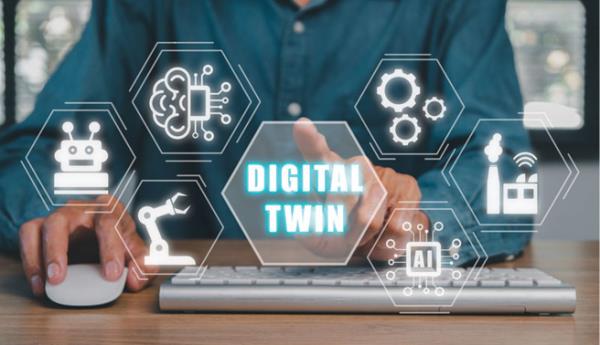08 May 2024

Khuong Quan, senior product manager – connectivity solutions, BICS
You’ve heard of a digital twin…but have you heard of a connectivity twin? There’s not a single soul in the manufacturing industry who hasn’t at least thought about digital twin implementation – 9 in 10 global manufacturing organisations are considering it today. The digital twin market is supposed to grow at a CAGR of roughly 30% until 207 – a similar growth rate to the overall market for IoT manufacturing, expected to reach $970 billion by 2028.
It’s easy to see why. Digital twins – which create virtual replicas of systems and objects – are the answer to analysing and testing the effectiveness, efficiency, and accuracy of IoT systems and devices without affecting the real-world system. Neat, but how intuitive are these digital twin solutions, really?
The short answer? Digital twins don’t give manufacturers the complete picture of potential faults and inefficiencies. In fact, without cloning their devices’ connectivity, manufacturers are leaving a lot of intelligence on the table that could be used to unlock even better value out of their IoT ecosystem.
Why IoT matters in the supply chain and manufacturing
The thing about manufacturing plants is that they’re immensely complex beasts. Changes in products and the processes to create them happen often, which means time and money can sometimes be flushed down the drain.
This is why over the last few years, manufacturers have been keen to leverage IoT to connect machines that can optimise that process, creating a safer, more efficient facility. They can have devices communicate with one another, sharing data to make autonomous decisions based on real-time information, or alert workers to performance and maintenance issues. Some of the popular use cases for IoT include safety monitoring, automating production line processes such as quality control, and providing more accurate data and analytics.
In the supply chain, IoT solutions can help track, manage, and deliver goods. Applications can help automate or monitor specific picking and packing processes, which brands like Amazon already make use of. They can even monitor the entire supply chain, just as Volvo has done by using IoT to track the delivery of vehicle parts across various countries.
If IoT provides the data, then digital twins are the thing that visualises and provides better visibility over the data – and there’s a whole lot of data. More specifically, digital twins are quite handy for the simulation and operational phases of manufacturing products and processes. Inevitably, different batches of products have variable levels of quality – some even have defects or inefficiencies in the process of how they’re made. By virtually cloning these assets, digital twins basically give manufacturers a way to get to the bottom of this by easily obtaining deeper insights and better visibility on their assets, production lines, end products, etc.
In theory, this all sounds great, but there’s a lot more to IoT that needs troubleshooting than just the devices themselves. In layman’s terms, any IoT application is made of three components: devices, application, and connectivity. You need the IoT devices to collect the data in the first place, the application to analyse and unlock value from the data, and finally, the connectivity to bind it all together.
It’s the last bit that often gets overlooked in IoT management. The importance of connectivity cannot be understated here. Many IoT applications are developed under the assumption that there will always be a fast and persistent internet connection powering the flow of real-time data from devices. In reality, though, if you’re not troubleshooting connectivity with twin technology, you’re effectively blind to a sizable source of problems that may slow processes down.
Connectivity needs a digital twin, too
Unfortunately, connectivity isn’t always persistent. We’ve seen on a bigger scale how entire factories can come to a halt during a network outage, but intermittent connectivity isn’t always easily visible. Often, the connectivity issue is device-specific, or the issue might be ‘poor’ connectivity as opposed to ‘no’ connectivity.
Just imagine if your smartphone told you how much battery it had left, but not the number of bars on your signal level. Sure, you could probably open up Safari on your iPhone and manually test for an internet connection, and that would work. But if you’re a manufacturer at a plant, imagine you’ve now got that same visibility problem for hundreds, if not more, IoT devices. You’re essentially guessing and praying that those devices are connected at all times even when they might not be.
This is where enterprises in manufacturing and beyond need to evolve their thinking about digital twins into ‘connectivity twins.’ In practice, this means virtually cloning the SIM or eSIM of a device to access information on connectivity. The end-to-end security view you get allows faster troubleshooting and service improvement. Time is money, as they say, and the last thing any manufacturer wants is poor connectivity slowing down their time to market.
To unlock the full potential of IoT data, any enterprise in manufacturing transitioning into large-scale IoT deployment must consider how they merge device or sensor data with crucial connectivity and network data. The synergy from this would provide profound operational insights, not to mention boost the service level delivered to customers, ensuring a more connected, efficient, and intelligent IoT ecosystem.
From an IoT management perspective, enterprises often have too many disparate platforms managing different elements and producing different data sets. They might have a device management platform and a separate SIM/connectivity management solution, both hosted on the cloud.
While the emergence of digital twin platforms from hyperscale cloud providers like AWS IoT TwinMaker and Azure Digital Twins has helped with the interconnection of data sources, connectivity management has to be brought inside the device management platform. This is the missing piece to IoT.
When having twins actually reduces stress levels

On a more granular level, twinning your connectivity comes with other benefits, too. Monitoring device firmware upgrades and managing data volume aggregation would certainly be simpler, for instance. Devices with poor coverage or performance could be identified quickly. Troubleshooting disconnected devices, network ID verification, and Radio Access Technology availability would be faster. You can imagine other use cases, such as accelerating GPS signal acquisition for efficient fleet management, or predicting the remaining battery life of devices to ensure uninterrupted service. You could even quickly block connectivity in cases of suspected fraud activity.
For this future to become a reality, manufacturers may have to lean on the expertise of telco vendors. While some manufacturers and enterprises may eventually be able to develop connectivity twin solutions themselves, if the ongoing digital skills gap in the UK is anything to go by, that seems unlikely anytime soon. More likely, we’ll see manufacturers collaborate with vendors offering low-code and no-code tools that streamline processes for developers building IoT apps and managing IoT data. The easier these connectivity twin solutions are to use and integrate, the more easily teams will be able to extract value from their IoT solutions.
If you want the complete picture of your IoT ecosystem, including all its bottlenecks, make connectivity another important branch to troubleshoot with digital twins. Connectivity twins aren’t just about a cool technological innovation. They could be the key to a future where IoT solutions are far more intuitive, powerful, and seamlessly integrated into enterprise operations.










